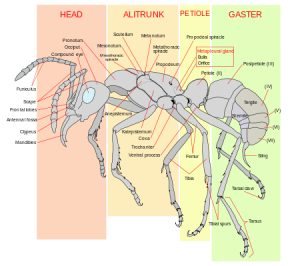No one likes seeing ants in the house, but carpenter ants can be especially bad news for buildings. Carpenter ants are especially difficult to remove because they make their home in wood (and love soft or damaged wood in particular). In fact, carpenter ants are sometimes mistaken for terminates because both insects burrow tunnels in wood. If you suspect you have a carpenter ant infestation, there are a few key signs to look out for.
Seeing ants is always the first tipoff of an infestation. If you notice ants in and around your home, take a closer look. The bottom segment of a carpenter ant (aka its thorax) will be smooth, and carpenter ants often have a visible notch on their waist. Noticing winged ants near walls or ceilings may be a key warning sign pf a carpenter ant infestation. Winged carpenter ants are looking for a mate, and their presence may mean a colony has been active for several years. However, seeing carpenter ants does not mean you have an infestation. Carpenter ants often look for food (and mates) quite far away from the nest.
Finding wood shavings and sawdust is another key signs of a potential carpenter ant infestation. Unlike termites, carpenter ants do not actually eat wood. Carpenter ants like their nests to be very smooth and clean, and remove the debris and sawdust they create as they burrow tunnels. This debris sometimes looks like irregularly-sized pencil shavings. It may also contain dust or segments from dead ants. Carpenter ants remove debris through slit-like openings (called ‘windows’) which may also be visible.
Carpenter ants are most active at night. You may be able to hear them by holding a glass up to the wall and tapping on it. A soft clicking or rusting sound may indicate carpenter ants. If you knock on the wall and it sounds hollow, that may be another telltale sign. It’s also important to know where to look. Carpenter ants prefer soft wood like pine, or wood that is moist or decaying. Inside, they like to live near water (kitchens, bathrooms, moist basements and leaky attics can be prime targets), and near door and window frames. Outside, carpenter ants are often drawn to damaged hardwood trees and tree stumps.
The presence of carpenter ants (particularly winged ants looking for mates), wood shavings and debris and rustling in the walls may all be signs of a carpenter ant infestation. If you suspect you may have a carpenter ant infestation, the best advice is to call a professional.





